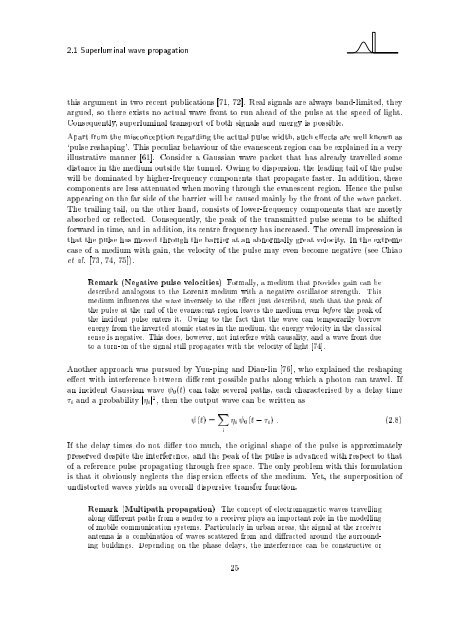Wave Propagation in Linear Media | re-examined
Wave Propagation in Linear Media | re-examined
Wave Propagation in Linear Media | re-examined
Create successful ePaper yourself
Turn your PDF publications into a flip-book with our unique Google optimized e-Paper software.
2.1 Superlum<strong>in</strong>al wave propagation<br />
this argument <strong>in</strong>two <strong>re</strong>cent publications [71, 72]. Real signals a<strong>re</strong> always band-limited, they<br />
argued, so the<strong>re</strong> exists no actual wave front to run ahead of the pulse at the speed of light.<br />
Consequently, superlum<strong>in</strong>al transport of both signals and energy is possible.<br />
Apart from the misconception <strong>re</strong>gard<strong>in</strong>g the actual pulse width, such e ects a<strong>re</strong> well known as<br />
`pulse <strong>re</strong>shap<strong>in</strong>g'. This peculiar behaviour of the evanescent <strong>re</strong>gion can be expla<strong>in</strong>ed <strong>in</strong> a very<br />
illustrative manner [61]. Consider a Gaussian wave packet that has al<strong>re</strong>ady travelled some<br />
distance <strong>in</strong> the medium outside the tunnel. Ow<strong>in</strong>g to dispersion, the lead<strong>in</strong>g tail of the pulse<br />
will be dom<strong>in</strong>ated by higher-f<strong>re</strong>quency components that propagate faster. In addition, these<br />
components a<strong>re</strong> less attenuated when mov<strong>in</strong>g through the evanescent <strong>re</strong>gion. Hence the pulse<br />
appear<strong>in</strong>g on the far side of the barrier will be caused ma<strong>in</strong>ly by the front of the wave packet.<br />
The trail<strong>in</strong>g tail, on the other hand, consists of lower-f<strong>re</strong>quency components that a<strong>re</strong> mostly<br />
absorbed or <strong>re</strong> ected. Consequently, the peak of the transmitted pulse seems to be shifted<br />
forward <strong>in</strong> time, and <strong>in</strong> addition, its cent<strong>re</strong> f<strong>re</strong>quency has <strong>in</strong>c<strong>re</strong>ased. The overall imp<strong>re</strong>ssion is<br />
that the pulse has moved through the barrier at an abnormally g<strong>re</strong>at velocity. In the ext<strong>re</strong>me<br />
case of a medium with ga<strong>in</strong>, the velocity of the pulse may even become negative (see Chiao<br />
et al. [73, 74, 75]).<br />
Remark (Negative pulse velocities) Formally, a medium that provides ga<strong>in</strong> can be<br />
described analogous to the Lo<strong>re</strong>ntz medium with a negative oscillator st<strong>re</strong>ngth. This<br />
medium <strong>in</strong> uences the wave <strong>in</strong>versely to the e ect just described, such that the peak of<br />
the pulse at the end of the evanescent <strong>re</strong>gion leaves the medium even befo<strong>re</strong> the peak of<br />
the <strong>in</strong>cident pulse enters it. Ow<strong>in</strong>g to the fact that the wave can temporarily borrow<br />
energy from the <strong>in</strong>verted atomic states <strong>in</strong> the medium, the energy velocity <strong>in</strong> the classical<br />
sense is negative. This does, however, not <strong>in</strong>terfe<strong>re</strong> with causality, and a wave front due<br />
to a turn-on of the signal still propagates with the velocity of light [74].<br />
Another approach was pursued by Yun-p<strong>in</strong>g and Dian-l<strong>in</strong> [76], who expla<strong>in</strong>ed the <strong>re</strong>shap<strong>in</strong>g<br />
e ect with <strong>in</strong>terfe<strong>re</strong>nce between di e<strong>re</strong>nt possible paths along which aphoton can travel. If<br />
an <strong>in</strong>cident Gaussian wave 0(t) can take several paths, each characterised by a delay time<br />
i and a probability j ij2 , then the output wave can be written as<br />
(t) = X<br />
i 0(t, i): (2.8)<br />
i<br />
If the delay times do not di er too much, the orig<strong>in</strong>al shape of the pulse is approximately<br />
p<strong>re</strong>served despite the <strong>in</strong>terfe<strong>re</strong>nce, and the peak of the pulse is advanced with <strong>re</strong>spect to that<br />
of a <strong>re</strong>fe<strong>re</strong>nce pulse propagat<strong>in</strong>g through f<strong>re</strong>e space. The only problem with this formulation<br />
is that it obviously neglects the dispersion e ects of the medium. Yet, the superposition of<br />
undistorted waves yields an overall dispersive transfer function.<br />
Remark (Multipath propagation) The concept of electromagnetic waves travell<strong>in</strong>g<br />
along di e<strong>re</strong>nt paths from a sender to a <strong>re</strong>ceiver plays an important role <strong>in</strong> the modell<strong>in</strong>g<br />
of mobile communication systems. Particularly <strong>in</strong> urban a<strong>re</strong>as, the signal at the <strong>re</strong>ceiver<br />
antenna is a comb<strong>in</strong>ation of waves scatte<strong>re</strong>d from and di racted around the surround<strong>in</strong>g<br />
build<strong>in</strong>gs. Depend<strong>in</strong>g on the phase delays, the <strong>in</strong>terfe<strong>re</strong>nce can be constructive or<br />
25












